Copenhagen Travel Guide
A relaxed, picturesque capital, Copenhagen is supremely well-organised and celebrated for its liberal outlook and eco-friendly attitude. Anyone fortunate enough to holiday in Copenhagen will testify to the fact that the lovely Danish capital is one of Europe's most impressive urban destinations. Its attractions are many, and easily accessible on foot, centuries of rich and interesting history show in its architecture, and there are a number of splendid upmarket shops. The are also far more Michelin-starred restaurants than in any other Scandinavian city. Visiting foodies may enjoy one of the city's gastronomic tours, too. They are two to four hours long and cover anything from Scandinavian cuisine to hygge: the hard to describe but easy to experience Danish obsession with getting cosy.
A holiday in Copenhagen is a magical experience for children and anyone who is young at heart, thanks to its wonderful Tivoli funfair and the association with Hans Christian Andersen's fairytales. In addition to enjoying the carefully well-preserved city centre, much of which dates from the late 18th century or earlier, culture vultures travel to Copenhagen to enjoy its many theatres, arts events and music concerts. The Danes have refused to compromise their traditional city centre with skyscrapers and the old city is blessedly free of high-rise buildings, creating an authentic old-world atmosphere.
Best time to visit Copenhagen
A summer holiday in Copenhagen (June to August) is ideal, especially for those intent on making the most of Tivoli Gardens, the city's popular amusement park, and the pavement cafes on the pretty squares. A Copenhagen holiday is also magical in the run-up to Christmas, when the snow-covered city takes on a fairytale aspect and it is fun to shop for gifts in the Christmas markets.
What to see in Copenhagen
-The heart of the city, Christiansborg Palace is the hub of Danish government and chock full of history.
-The iconic Little Mermaid statue in Langelinie Harbour is one of Copenhagen's most famous sights.
-Copenhagen is rich in world-class museums, including the Copenhagen City Museum.
-Rosenborg Castle is the historic seat of Danish royalty and houses the crown jewels.
What to do in Copenhagen
-For a taste of Copenhagen's liberal 'hippy' culture visit Freetown Christiania.
-A stroll or a boat ride down the historic Nyhavn Canal is a must.
-For thrills, spills and fresh air, Tivoli Gardens can't be missed.
-Bakken Amusement Park, said to be the oldest in the world, is a must for families travelling with kids.
Beyond Copenhagen
Popular excursions and daytrips from Copenhagen include visits to Frederiksborg Palace, in North Zealand; the UNESCO-listed Kronborg Castle, in Helsingor, immortalised in Shakespeare's Hamlet; the island of Bornholm, known as the 'Pearl of the Baltic'; the historic city of Aarhus, on the east coast of Jutland; and the beautiful island of Funen (Fyn), with its capital Odense, the birth place of Hans Christian Andersen. Families travelling with kids should be sure to visit Legoland Billund, the original Legoland Park.
Getting there
Copenhagen Airport, situated five miles (8km) southeast of Copenhagen city centre, on the island of Amager, is the biggest airport in Scandinavia and the point of entry for the majority of visitors to Denmark.
Did you know?
-Copenhagen was once a fortified city, with only three entrances.
-There is only one high-rise building in Copenhagen's city centre: the Radisson Blu Royal Hotel, built in 1960.
-Copenhagen has been rated as one of the world's top cities for cyclists.
Things to do in Copenhagen
Attractions in Copenhagen are a mix of fascinating history and fun activities. Its many cobblestone streets and rows of old Danish houses are much like they've been for centuries, occupied by wonderful shops and carnival-style entertainment.
The Little Mermaid statue in Langelinie harbour is one of the city's most sought after sights for visitors, despite its small size. Other attractions await in unique neighbourhoods, grand museums and entertainment venues, usually reached on foot and mostly found in the old city centre of Copenhagen.
A walk along Nyhavn Canal reveals the best of historic Copenhagen with old architecture and wooden boats showcasing the city's maritime history. For those interested in delving deeper into the Danish past, the National Museum at the Prince's Palace is a central Copenhagen attraction, as is the Copenhagen City Museum.
Copenhagen also has a proud heritage of art and design, well showcased in numerous museums, galleries and architecture. Of course, no visit to Copenhagen is complete without idling in the Tivoli Gardens or playing in its famous theme park.
The Copenhagen Card is useful too, giving free entry to more than 70 museums and attractions, free rides on public transportation, and discounts in many restaurants and shops. The cards can be purchased at the airport or at many tourist offices around Denmark.
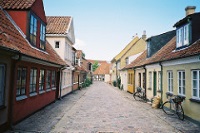
Odense
Sixty miles (96km) west of Copenhagen and located on the island of Funen, Odense is Denmark's third largest city and a vibrant centre of commerce and nightlife. In this busy harbour city, the quaint streets of the Old Town offer interesting shops, cafes and restaurants all buzzing with activity. Odense has a long history going back thousands of years, with archaeological finds dating to the Viking era. Birthplace of famed storyteller Hans Christian Andersen, there's a strong affinity between the city and the writer, with a number of shops and restaurants dedicated to him. The town also has several beautiful castles, cathedrals and museums, while the music and nightlife is among the best in Denmark, featuring symphonies, theatre and non-stop outdoor festivities in the idyllic summer months.
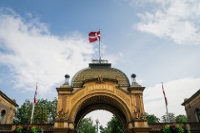
Tivoli Gardens
The world-renowned Tivoli Gardens in the heart of Copenhagen is one of the world's most thrilling entertainment complexes, drawing about three million visitors during its five-month summer open season each year. Tivoli dates back to 1843 when Copenhagen was still a fortified city surrounded by tall ramparts and a deep moat. Today, the Tivoli Lake is all that remains of the moat, which now reflects the incredible trademark fireworks displays that light the sky over the gardens twice a week. Tivoli is split in two, one section housing the beautiful miniature gardens where more than 100,000 flowers bloom, and the other has the theme park, with arcades and thrill rides. Tivoli also boasts a concert hall and open-air stages where dozens of concerts, pantomimes and circus shows come to life.
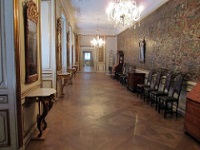
Copenhagen Historical Museums
From the Viking Age through to World War II resistance, the rich history of Denmark is encapsulated in fascinating collections of artefacts housed in a series of museums in Copenhagen. The Prince's Palace houses the National Museum, covering Danish history and international antiquities. A few miles north, the open air museum makes for a fascinating excursion. Spread over 86 acres, its 100 or so historic buildings are built to illustrate and represent regions and periods across Denmark. Visitors can get up to date on the history of the city itself at the Museum of Copenhagen.

Nyhavn Canal
The picturesque and historic Nyhavn Canal in Copenhagen dates from 1673, when it was built to connect the inner city to the sea. Today, it's jokingly referred to as the longest bar in Scandinavia because of the numerous restaurants, pubs and cafes fronting the pretty pastel-painted townhouses. The canal itself is crammed with old wooden sailing ships, which only add to the atmosphere. The area is strongly associated with fairytale writer Hans Christian Andersen, who occupied three houses in the district throughout his life. Visitors can take one of the many boat trips on offer to explore the canal and familiarise themselves with the area.
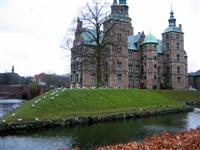
Rosenborg Castle
The attractive Dutch Renaissance-style Rosenborg Castle was designed by King Christian IV and served as his home until he died in 1648. Today, the castle is an important cultural institution and acts as a public museum detailing the history of Denmark's royal family. It also acts as a repository for the Danish Crown Jewels and royal regalia, which are kept in the castle cellars and can be viewed by the public. Although opulent, the castle also feels surprisingly personal and intimate for a royal residence, with the magnificent gardens a welcome retreat from the city's hustle and bustle.
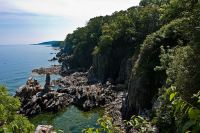
Bornholm
Sometimes referred to as the Pearl of the Baltic, Bornholm is wildly popular as a holiday destination for people from Sweden, Poland and Germany. Often overlooked by visitors from the US and UK, tourists enjoy the island's sunny beaches and natural beauty. It's loved for activities such as sailing, fishing, camping and hiking. The Almindingen Forest is among the largest in Denmark, while Dueodde boasts some of the best sandy beaches in the Baltic. A number of small towns have their own attractions, including Gudhjem's sunrises and charming winding streets, the jazz festival at Allinge and the bustling markets and local beers of Svaneke. The biggest town on Bornholm is Rønne, where most ferries disembark, and it features pretty 19th-century architecture and a collection of museums, shops and restaurants.
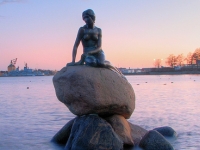
The Little Mermaid Statue
The Little Mermaid, so synonymous with writer Hans Christian Andersen, sits on a rock at the Langelinie Harbour and is one of Copenhagen's biggest tourist attractions. The sculpture was built in 1913 and enchants over a million visitors every year. At only about four feet (1.25m) high, she is small and seems to be in her true element when the waves crash against her rock. The sculptor Edvard Eriksen modelled the head after ballerina Ellen Price. It's beautifully executed and fits so well into its natural surroundings that it may take a moment to notice it.
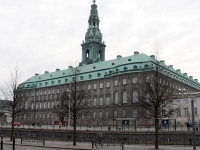
Christiansborg Palace
When sightseeing in Denmark, architecture enthusiasts and history buffs fall in love with the Christiansborg Palace. A winter snowfall adds to its romantic fairytale appearance, its appeal further enhanced by the presence of ruins dating as far back as 1167 AD, when it existed as Absalon's Castle. The complex consists of several different buildings, centred round a Baroque Revival core and home to important institutions such as the Danish Parliament, the Prime Minister's Office and the Supreme Court. The royal family uses the palace church, the Royal Reception Rooms and the Riding Ground Complex.

Legoland Billund
The original Legoland is a holiday must for children visiting Denmark. Opened in 1968, it welcomes visitors from all over the world and is conveniently situated next to the original Lego factory. The theme park is divided into different worlds with different themes, often based on the latest Lego ranges, and has a legendary selection of rides, shops and eateries. The admission costs vary because there are so many different ticket options, including season passes, family tickets, multiple pre-booked online ticket options, as well as ordinary gate prices, so it's best to double check the website.
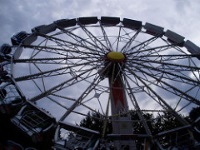
Bakken Amusement Park
The oldest amusement park in the world and one of Denmark's favourites, Bakken Amusement Park has delighted countless visitors since it first opened in 1583. Despite its age, the park and its amenities are modern and safe, featuring 34 thrilling rides. There are also lots of games, activities and gambling facilities. Bakken has about 40 restaurants and bars where families can relax and refuel. Just outside the amusement park gates is the beautiful woodland area of Dyrehaven, which offsets the artificial glories of the park with natural charm. The woods are a lovely place to stroll and are home to thousands of free-roaming deer.
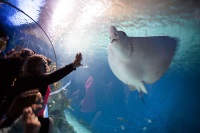
Denmark Aquarium
The Denmark Aquarium boasts more than 300 species of marine life from across the globe. It's not large compared to other huge aquariums in Europe, but it's well maintained and a wonderful attraction for the whole family. Kids adore this magical underwater world, which provides a good break from traditional sightseeing in Copenhagen. They will love the themed interactive exhibits and touch pool, while other facilities include a cafe where visitors can take a break and enjoy lovely views with tasty meals, treats or hot drinks.
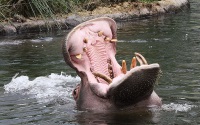
Copenhagen Zoo
Founded in 1859, the Copenhagen Zoo is one of the oldest in Europe and features an amazing selection of animals from all over the world. Some of the zoo's most popular features include the Elephant House, designed by renowned architect Norman Foster; Tasmanian Devils, very rarely found in any zoo outside of Australia; the polar bear enclosure; and the lion den. Notable animals in the 27 acre (11 hectare) park include tigers, red pandas, hippos, yaks and camels. The animals are well looked after and the habitat designs are impressive. The staff are famous for their care for their animals and are usually willing to chat to visitors about them.
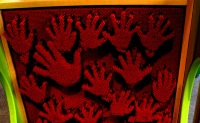
Experimentarium
Featuring almost 300 interactive exhibitions for children of all ages, the Experimentarium is a hands-on science museum that aims to encourage youngsters to take an interest in science in fun ways. There are various exhibits, including ones on energy, the human body and mathematics, as well as other interactive areas. With permanent and temporary exhibitions, visitors can be sure that there is always something new, fun and exciting for children to enjoy. The bubble section tends to be a big favourite, while the museum also features a cafe and restaurant, workshop facilities and a gift shop with exciting scientific toys and games. This is a great activity for the whole family and is the perfect kid-orientated break from traditional sightseeing.
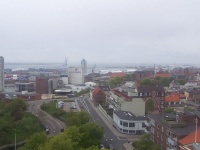
Esbjerg
Esbjerg is a popular holiday town, loved for its gorgeous beaches, art scene and thriving cafe culture. Most of Esbjerg's tourist attractions are nautical by nature, including the Sealarium at the Fisheries and Maritime Museum. A boat trip round the harbour is a must, and there's plenty of golf and watersports to indulge in.
Being a city with a large youthful population, there's always a fair amount of dancing and music in its bars and clubs. However, the best thing about Esbjerg is its proximity to the scenic Jutland Peninsula, with its wide windswept sand dunes and popular family attractions such as Legoland at Billund. Travellers should also visit the picturesque medieval town of Ribe (the oldest town in Scandinavia), and offshore resort islands such as Rømø and Fanø.
Home to charming half-timbered houses and winding cobble streets, Ribe is right next to the Wadden Sea: a national park and UNESCO site where the North Sea's water flows into the Wadden Sea twice a day, flooding the mud flats with seawater. During low tide, visitors can drive out and experience what it's like to walk on the sea bed. Rømø has one of the widest beaches in northern Europe and hosts one of the Europe's largest kite festivals. Those who visit Fanø can collect amber that washes up on the beach after periods of stormy weather, or cruise along the shore in a three-wheeled, sail-driven vehicle called a Blokart.
Things to do with kids in Copenhagen
Copenhagen is a safe and friendly place with world-class amenities. Visitors travelling with children will find an abundance of fantastic and exciting attractions geared towards kids, making this a wonderful city for the whole family to enjoy.
A trip to Copenhagen must include a visit to Tivoli Gardens, which boasts beautiful miniature gardens, a theme park with arcade games and rides, and even open air stages where plays and concerts take place.
The Bakken Amusement Park is great for warm days and is the oldest of its kind in the world, having opened in 1583. The Nature Playground, located at Valbyparken, is also a must for a picnic out in the sunshine and fresh air. Indeed, there are numerous parks and green areas in Copenhagen where families can play and relax.
On colder days when outdoor activities with kids aren't an option, families can head off to the Denmark Aquarium, the wonderful Copenhagen Zoo or the Mystic Exploratorie, a fantastic place where kids are equally thrilled and perplexed.
For toddlers, the Kompan indoor playground is a wonderland of slides, balls and bright colours. Children will also enjoy some of the more traditional sightseeing attractions, such as palaces and castles that delight young imaginations.

Bakken Amusement Park
The oldest amusement park in the world and one of Denmark's favourites, Bakken Amusement Park has delighted countless visitors since it first opened in 1583. Despite its age, the park and its amenities are modern and safe, featuring 34 thrilling rides. There are also lots of games, activities and gambling facilities. Bakken has about 40 restaurants and bars where families can relax and refuel. Just outside the amusement park gates is the beautiful woodland area of Dyrehaven, which offsets the artificial glories of the park with natural charm. The woods are a lovely place to stroll and are home to thousands of free-roaming deer.

Denmark Aquarium
The Denmark Aquarium boasts more than 300 species of marine life from across the globe. It's not large compared to other huge aquariums in Europe, but it's well maintained and a wonderful attraction for the whole family. Kids adore this magical underwater world, which provides a good break from traditional sightseeing in Copenhagen. They will love the themed interactive exhibits and touch pool, while other facilities include a cafe where visitors can take a break and enjoy lovely views with tasty meals, treats or hot drinks.

Copenhagen Zoo
Founded in 1859, the Copenhagen Zoo is one of the oldest in Europe and features an amazing selection of animals from all over the world. Some of the zoo's most popular features include the Elephant House, designed by renowned architect Norman Foster; Tasmanian Devils, very rarely found in any zoo outside of Australia; the polar bear enclosure; and the lion den. Notable animals in the 27 acre (11 hectare) park include tigers, red pandas, hippos, yaks and camels. The animals are well looked after and the habitat designs are impressive. The staff are famous for their care for their animals and are usually willing to chat to visitors about them.

Experimentarium
Featuring almost 300 interactive exhibitions for children of all ages, the Experimentarium is a hands-on science museum that aims to encourage youngsters to take an interest in science in fun ways. There are various exhibits, including ones on energy, the human body and mathematics, as well as other interactive areas. With permanent and temporary exhibitions, visitors can be sure that there is always something new, fun and exciting for children to enjoy. The bubble section tends to be a big favourite, while the museum also features a cafe and restaurant, workshop facilities and a gift shop with exciting scientific toys and games. This is a great activity for the whole family and is the perfect kid-orientated break from traditional sightseeing.
Eating Out
The guarantors of Michelin dining have bestowed 15 restaurants in Copenhagen with their prestigious mark of excellence. While obviously many popular restaurants in Copenhagen are not included, the honours are indicative of how far dining has progressed in the city.
Traditionally, Denmark has not been known for its food; Frikadeller meatballs and cabbage are among the most popular dishes. While there are some great Danish foods such as their hotdogs and open-faced sandwiches, much of the truly great culinary experiences in Copenhagen deals in international cuisine, particularly French and Asian.
Dining in Copenhagen is usually a leisurely affair and patrons are encouraged to take their time and make a night of it. For quicker eats, cafes and hot dog stands are very popular and a fun way to meet people, or travellers can grab a fresh sandwich at one of the city's many bakeries. Stoget, Central Station and Grey Friars Square are all hotspots for restaurants. Tivoli also has a great selection of casual eateries in fun settings.
Shopping
A day of shopping in Copenhagen is brilliant but can be a spectator sport for those without large amounts of money to spend. Rådhuspladsen Square (City Hall Square) marks the start of Strøget, the longest pedestrian mall in the world. It comprises five streets and two miles (3.2km) of retail heaven, and it's where Copenhagen's main stores can be found, as well as cafes for weary shoppers to stop and refuel. Many sports or music celebrations take place here. At the top end of Strøget, shoppers with a penchant for designer labels can splurge at Prada, Chanel and Versace, while Magasin du Nord, Scandinavia's largest department store, is also found in this area.
Lego can be scooped up cheaply, while Scandinavian Crystal and Royal Copenhagen porcelain are not to be forgotten. Shops in Copenhagen are mostly open from 9.30am to 5pm from Monday to Friday, and from 9am to 4pm on Saturdays.
Nightlife
Nightlife in Copenhagen has a couple of gears and the real party doesn't start until late at night. Most jumpstart the evening in a variety of cafes and bars, ranging from renovated historic buildings with new edgy decor to newly built and fashionable eateries.
Themed bars are a perfect way to begin the night, as they let patrons enjoy easy listening music and nice meals before late-night DJs take over with more energetic tracks. Certain areas of the city, such as Nyhavn and Boltens Gård, are long-time Copenhagen nightlife districts that always promise great venues, often staying open until about 5am.
The 150-year-old Pantomime Theatre stages commedia dell'arte productions with free admission, while the modern Tivolis Koncertsal offers classical entertainment from opera to symphonies. Last-minute discounted tickets are often available at the ticket kiosk across from the Nørreport train station at the corner of Fiolstræde and Nørre Voldgade.
Getting Around
Trains, Busses (including water busses) and the metro operate on a one-fare system, where tickets are valid for all three types of transport with no extra cost for transfer. Bus services are frequent between 5am and 1am, with night buses operating after regular hours. The metro runs from Vanlose Station to Lergravsparken in East Amager, to Orestad in West Amager and to Frederiksberg, operating 24 hours a day, seven days a week.
A favourite mode of transport for locals and visitors is the bicycle, and Copenhagen has cycle paths and routes along all major streets. Bikes can be rented for around 120 DKK per day, though helmets are not included and cost 40 DKK extra. Bycyklen (the city's bike-share program) costs 1 DKK per minute and has over 130 stations around the city.
Copenhagen is also well supplied with licensed taxis, but traffic is usually congested in the city centre and a car can be a liability rather than an asset. Ride-sharing apps include GoMore and Taxa 4x35.
Copenhagen Climate and Weather
Copenhagen's continental climate is mild through all four seasons. Summers (June to August) bring temperatures averaging around 68F (20C), while in mid-winter (December to February) temperatures hover just above or below freezing. The hottest month is July and the coldest month is February. Rainfall is moderate too, but showers are possible in any season. Winter days get far fewer daylight hours than summer days, which are long. Early summer is the best time to visit Denmark; the month of June is particularly lovely because the days are longest and the weather is at its most pleasant.
Denmark travel info
Electricity
Electrical current is 230 volts, 50Hz. Round European-style, two-pin plugs are standard.
Language
Danish is the official language, but English is understood and widely used.
Money
Danish currency is the krone (DKK), made up of 100 ore. ATMs are easily found throughout the country, and all major credit cards are widely accepted, especially Visa. Most banks are not open on weekends but Copenhagen has several bureaux de change that stay open late at night, seven days a week.
Tipping
Those working in Denmark's service industry generally receive good wages. Service charges are usually included in bills so tipping isn't common. However, small tips are appreciated by bellhops, valets, maids, porters, or taxi drivers if guests feel the service has been good. Usually rounding up to the nearest kroner is acceptable.
Health
There are no specific health risks in Denmark and medical facilities are first class. No vaccinations are required, though eligible travellers should be up to date with their COVID-19 vaccines; free emergency treatment is available to all foreign visitors at public hospitals. After Brexit, the Global Health Insurance Card (GHIC) replaced the European Health Insurance Card (EHIC) for UK citizens. The GHIC allows UK citizens access to state healthcare during visits to the EU. The GHIC is not valid in Norway, Iceland, Liechtenstein or Switzerland, nor is it an alternative to travel insurance.
Safety
Most visits to Denmark are trouble free and crime levels are low, but tourists should be wary of opportunistic muggers, pickpockets and bag snatchers, especially in crowded areas, train stations and bus stops. Visitors should take precautions to keep personal belongings safe.
Local customs
Denmark is an egalitarian society. Women and men are treated equally.
Doing business
Business in Denmark tends to be conducted in a straightforward manner, though somewhat less formally than in some other parts of Europe. Greetings are made with a handshake, introductions are usually made using one's first name and it's normal to greet women first.
Punctuality is vital and, if running even five minutes late, it's important to call and apologise. Danes tend to be open-minded and friendly, and one can expect some small talk at the start of a meeting on a range of topics. Business cards are exchanged before or after the meeting.
Dress should be smart and neat, without being ostentatious, and English is widely spoken and understood. Business hours are usually 9am to 5pm, Monday to Friday. In the summer months (June to August), some Danes are on holiday, so it's best to check before arranging a business trip.
Duty free
Residents of non-EU countries entering from outside the EU are allowed 200 cigarettes or 100 cigarillos or 50 cigars or 250 grams of tobacco, as well as 1 litre of spirits, 4 litres of wine and 16 litres of beer.
Communications
The international country code for Denmark is +45. visitors can purchase local prepaid SIM cards for unlocked phones; public WiFi is widespread.
Passport & Visa
The borderless region known as the Schengen Area includes the following countries: Austria, Belgium, Czech Republic, Denmark, Estonia, Finland, France, Germany, Greece, Hungary, Iceland, Italy, Latvia, Liechtenstein, Lithuania, Luxembourg, Malta, The Netherlands, Norway, Poland, Portugal, Slovakia, Slovenia, Spain, Sweden, and Switzerland. All these countries issue a standard Schengen visa that has a multiple entry option, and which allows the holder to travel freely within the borders of all the aforementioned countries. Additionally, travellers to Denmark must hold proof of the following: return or onward tickets, with confirmed reservations; the required documentation for the next destination; visible means of support (at least DKK 350) per day of stay in Denmark. It is highly recommended that travellers' passport has at least six months' validity remaining after the intended date of departure from their travel destination. No documents issued more than 10 years priot to date of travel will be accepted. Immigration officials often apply different rules to those stated by travel agents and official sources.
Entry requirements
United States citizens must have a passport valid for at least three months beyond period of intended stay. No visa is required for a stay of up to 90 days within a six month period, extension of stay is possible. There are no COVID-19 related requirements regarding test or self-isolation when entering Denmark.
UK citizens must have a passport valid for at least three months beyond period of intended stay. No visa is required for a stay of up to 90 days within a six month period, extension of stay is possible. There are no COVID-19 related requirements regarding test or self-isolation when entering Denmark.
Canadian citizens must have a passport valid for at least three months beyond period of intended stay. No visa is required for a stay of up to 90 days in a six-month period. There are no COVID-19 related requirements regarding test or self-isolation when entering Denmark.
Australian citizens must have a passport valid for at least three months beyond period of intended stay. No visa is required for a stay of up to 90 days in a six-month period. There are no COVID-19 related requirements regarding test or self-isolation when entering Denmark.
South African citizens must hold a passport, not a temporary passport, valid for at least three months beyond period of intended stay. A Schengen 'C' type visas must be valid for the visited Schengen Member State. There are no COVID-19 related requirements regarding test or self-isolation when entering Denmark.
Irish nationals must have a passport valid for the duration of their stay. No visa is required. There are no COVID-19 related requirements regarding test or self-isolation when entering Denmark.
New Zealand citizens must have a passport valid for at least three months beyond period of intended stay. No visa is required for a stay of up to 90 days in a six-month period. There are no COVID-19 related requirements regarding test or self-isolation when entering Denmark.
Useful contacts
Danish Visitor Service, Copenhagen: +45 70 22 24 42 or www.visitdenmark.com
112 (General)Embassies / consulates in other countries
Royal Danish Embassy, Washington DC, United States: +1 202 234 4300.
Royal Danish Embassy, London, United Kingdom: +44 (0)20 7333 0200.
Royal Danish Embassy, Ottawa, Canada: +1 613 562 1811.
Royal Danish Embassy, Canberra, Australia: +61 (0)2 6270 5333.
Royal Danish Embassy, Pretoria, South Africa: +27 (0)12 430 9340.
Royal Danish Embassy, Dublin, Ireland: +353 (0)1 475 6404.
Royal Danish Consulate General, Auckland, New Zealand: +64 22 047 3500.
Embassies / consulates in Denmark
United States Embassy, Copenhagen: +45 3341 7100.
British Embassy, Copenhagen: +45 3544 5200.
Canadian Embassy, Copenhagen: +45 3348 3200.
Australian Embassy, Copenhagen: +45 7026 3676.
South African Embassy, Copenhagen: +45 3918 0155.
Irish Embassy, Copenhagen: +45 35 47 3200.
New Zealand Consulate General, The Hague (also responsible for Denmark): +31 70 346 9324.



